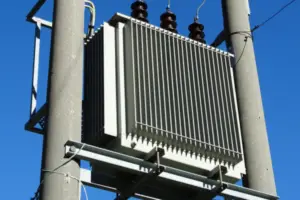Transformers play a crucial role in electrical power distribution by stepping up or stepping down voltage levels. Maintaining proper voltage is essential for the efficient functioning of electrical systems.
However, transformers can experience low voltage issues, leading to various problems. Low voltage in a transformer can be caused by factors such as increased winding resistance, core saturation, load imbalance, faulty connections, voltage regulation issues, overloading, and aging.
In this article, we will explore the causes of low voltage in transformers and discuss possible solutions to address these issues.
Table of Contents
Understanding Transformer Basics
A transformer is an electrical device that transfers electrical energy between two or more circuits through electromagnetic induction.
It consists of primary and secondary windings, a magnetic core, and insulation. The primary winding receives the electrical power, while the secondary winding delivers the transformed voltage.
Factors Affecting Transformer Voltage
Low voltage in transformers can be attributed to several factors, both primary and secondary causes. Let’s take a closer look at each of these factors.
Primary Causes of Low Voltage
1. Winding Resistance
Winding resistance refers to the inherent resistance of the transformer windings. Over time, due to aging or poor maintenance, the resistance may increase.
This increased resistance leads to voltage drops across the windings, resulting in low output voltage.
2. Core Saturation
Core saturation occurs when the magnetic core of the transformer reaches its maximum magnetic flux density.
When the core becomes saturated, it cannot effectively transfer energy, leading to reduced voltage output.
3. Load Imbalance
Load imbalance refers to an uneven distribution of electrical load on the transformer. If the load on the transformer is not evenly distributed across its windings, some windings may experience higher currents, causing voltage drops and resulting in low voltage output.
4. Faulty Connections
Faulty connections, such as loose or corroded terminals, can contribute to low voltage in a transformer.
These connections introduce resistance into the electrical path, leading to voltage losses.
Secondary Causes of Low Voltage
1. Voltage Regulation Issues
Voltage regulation refers to the ability of a transformer to maintain a steady output voltage under varying load conditions.
If a transformer has poor voltage regulation, it may experience significant voltage drops when subjected to increased loads, resulting in low voltage output.
2. Overloading
Transformers have specific load limits beyond which they can become overloaded. Overloading a transformer causes excessive heat buildup, leading to increased resistance and subsequently low voltage output.
Read my article: Transformer Overloading: Understanding the Causes and Consequences
3. Aging and Wear
As transformers age, their performance can degrade due to factors such as insulation breakdown, core deterioration, or winding damage.
These aging-related issues can contribute to the low voltage output.
Detailed Explanations of Causes
A. Winding Resistance
Winding resistance occurs due to the inherent resistance of the transformer windings. It can increase over time due to temperature variations, moisture, or poor maintenance practices.
Increased winding resistance results in voltage drops across the windings, leading to low output voltage.
B. Core Saturation
Core saturation occurs when the magnetic core of the transformer reaches its maximum magnetic flux density.
This can happen due to excessive voltage levels, high fault currents, or improper design. When the core becomes saturated, it cannot effectively transfer energy, resulting in low voltage output.
C. Load Imbalance
Load imbalance occurs when the electrical load is not evenly distributed across the transformer windings.
It can be caused by factors such as unequal distribution of connected loads, single-phase loads on a three-phase transformer, or faulty connections. Load imbalance leads to voltage drops in specific windings, causing low voltage output.
Read also my comprehensive article: Why Transformers Need a Minimum Load: Understanding the Basics.
D. Faulty Connections
Faulty connections, such as loose terminals, corroded connectors, or poor splices, introduce resistance into the electrical path.
This resistance leads to voltage losses, resulting in low voltage output. Faulty connections can occur due to poor installation, inadequate maintenance, or environmental factors like moisture and corrosion.
E. Voltage Regulation Issues
Voltage regulation refers to a transformer’s ability to maintain a consistent output voltage despite varying load conditions.
Transformers with poor voltage regulation may experience significant voltage drops under high load conditions, leading to low voltage output.
F. Overloading
Overloading a transformer by exceeding its rated capacity causes excessive heat buildup. This heat can damage the insulation, increase winding resistance, and lead to low voltage output.
Overloading can occur due to incorrect load calculations, the addition of new equipment without considering transformer capacity, or unexpected load spikes.
G. Aging and Wear
As transformers age, they may experience deterioration in insulation, core laminations, or winding integrity.
These aging-related issues can increase resistance, introduce imbalances, and contribute to low voltage output.
Factors like environmental conditions, operating temperatures, and maintenance practices can impact the rate of aging.
Detecting and Troubleshooting Low Voltage
To detect and troubleshoot low voltage issues in transformers, several measures can be taken.
Regular monitoring of voltage levels, testing and inspection procedures, and common troubleshooting techniques can help identify and address low-voltage problems promptly.
Preventive Measures and Solutions
Certain measures can be adopted to prevent and address low voltage issues in transformers.
Regular maintenance practices, such as checking and tightening connections, monitoring temperature and load levels, and conducting insulation resistance tests, can help ensure optimal transformer performance.
Load balancing, corrective actions for faulty connections, and upgrading or replacing aging transformers are also important preventive measures.
Conclusion
Maintaining proper voltage levels in transformers is crucial for the efficient functioning of electrical systems.
Various factors, including winding resistance, core saturation, load imbalance, faulty connections, voltage regulation issues, overloading, and aging, can contribute to low voltage output in transformers.
By understanding these causes and implementing preventive measures, such as regular maintenance and load balancing, the risk of low voltage issues can be minimized, ensuring the reliable operation of transformers and electrical systems.
Don’t Leave Empty-Handed!
Install my Free Android App on Google Play:
Electrical Cables Most Common Tables “Cables Tables”
And, my Electrical Calculations App “Fast Electrical Calculator”
Discover more great content by subscribing to My channel
Looking to stay ahead of the game in the world of electrical engineering? Subscribe to my YouTube channel and gain access to exclusive content you won’t find anywhere else!
The staff I recommend
(Amazon Affiliate Links to products I believe are high quality):
- Economy 120 Volt/60Hz AC Power Source – Step-Down Voltage & Frequency Converters 1800W
- UNI-T Digital Multimeter Tester UT139C
- 50-Amp Extension Cord for RV “100ft”
- Voltage Stabilizer 110/220v
- Hair Dryer “best selling“
- TOSHIBA EM131A5C-BS Countertop Microwave Ovens
Disclaimer: This contains affiliate links to Amazon products. I may earn a commission for purchases made through these links.


